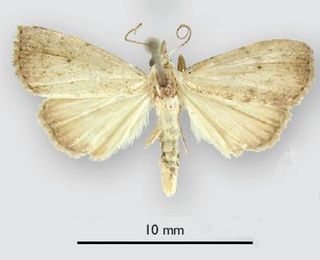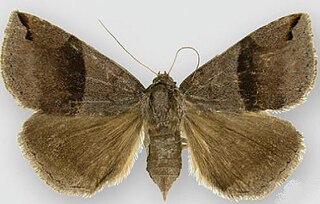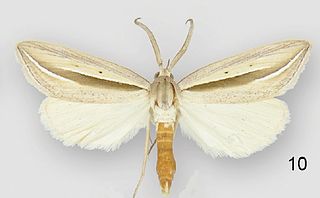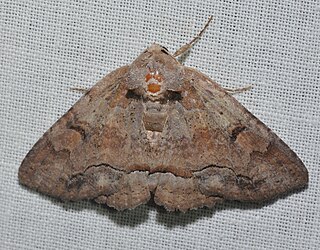
The Ophiusini are a tribe of moths in the family Erebidae.

Argyrosticta is a genus of moths of the family Noctuidae. The genus was erected by Jacob Hübner in 1821.

Gondysia is a genus of moths in the family Erebidae.

Heterochroma is a genus of moths of the family Noctuidae. The genus was erected by Achille Guenée in 1852.

Ptichodis is a genus of moths in the family Erebidae. The genus was erected by Jacob Hübner in 1818.

Rivula stepheni is a species of moth of the family Erebidae first described by James Bolling Sullivan in 2009. It is found in the US in eastern North Carolina, Louisiana and Florida.

Gondysia similis, the gordonia darkwing is a moth of the family Noctuidae. The species was first described by Achille Guenée in 1852. It is found in the US from North Carolina to Mississippi and Florida. The food plant occurs in Alabama and Mississippi and the moth could be expected from these areas as well.

Gondysia smithii, or Smith's darkwing, is a moth of the family Noctuidae. The species was first described by Achille Guenée in 1852. It is found in the United States, from North Carolina southward to Georgia and westward to Texas northward in the Mississippi Valley to Missouri. It has recently been recorded from Virginia and Florida but not yet from Louisiana or Arkansas, although it does occur close by and would be expected in those states as well. It occurs in open savanna and mesic woodland habitats.

Gondysia consobrina, the consobrina darkwing moth, is a moth of the family Noctuidae. The species was first described by Achille Guenée in 1852. It is found in the US, from North Carolina to Louisiana. Specimens have been recorded from all of the south-eastern states in the range except Alabama and Tennessee.

Zale lunifera, the bold-based zale or pine barrens zale, is a moth of the family Noctuidae. The species was first described by Jacob Hübner in 1818. It occurs primarily east and south of the Appalachian Mountains, from southern Maine south to Lee County, Mississippi, Mississippi and Florida. It is not known from south-eastern Virginia or South Carolina, but the species may occur in these regions. Lack of suitable habitat in Maryland and Delaware makes occurrence in these states unlikely. It also occurs inland to the mountains of Virginia and Lebanon County, Pennsylvania. In south-eastern Georgia it inhabits open, sandy pine-oak forest.

The Erebinae are a subfamily of moths in the family Erebidae erected by William Elford Leach in 1815. Erebine moths are found on all continents except Antarctica, but reach their greatest diversity in the tropics. While the exact number of species belonging to the Erebinae is not known, the subfamily is estimated to include around 10,000 species. Some well-known Erebinae include underwing moths (Catocala) and witch moths (Thermesiini). Many of the species in the subfamily have medium to large wingspans, up to nearly 30 cm in the white witch moth, which has the widest wingspan of all Lepidoptera. Erebine caterpillars feed on a broad range of plants; many species feed on grasses and legumes, and a few are pests of castor bean, sugarcane, rice, as well as pistachios and blackberries.

Argyrostrotis flavistriaria, the yellow-lined chocolate moth, is a moth of the family Noctuidae. The species was first described by Jacob Hübner in 1831. It is found in the US from North Carolina south to Florida and Texas.

Argyrostrotis sylvarum, the woodland chocolate moth or brown wavy line argyrostrotis, is a moth of the family Noctuidae. The species was first described by Achille Guenée in 1852. It is found in the US from Virginia south to Florida and Texas.

Argyrostrotis erasa, the erasa chocolate moth, is a moth of the family Noctuidae. The species was first described by Achille Guenée in 1852.) It is found in the US from North Carolina south to Florida and Texas.

Argyrostrotis deleta is a moth of the family Noctuidae first described by Achille Guenée in 1852. It is found in the United States from Virginia south to Florida and Texas.

Argyrostrotis quadrifilaris, the four-lined chocolate moth, is a moth of the family Noctuidae. The species was first described by Jacob Hübner in 1831. It is found in the US from New York and New Hampshire south to Florida and Texas.

Doryodes spadaria, the dull doryodes moth, is a moth of the family Erebidae. The species was first described by Achille Guenée in 1857. It is found in North America, where it has been recorded from coastal Florida, Georgia, North Carolina, South Carolina and Texas. The habitat consists of salt marshes.

Doryodes fusselli is a moth of the family Erebidae first described by J. Donald Lafontaine and James Bolling Sullivan in 2015. It is found in the US state of North Carolina, occurring from Dare County in the north to Brunswick and New Hanover counties in the south.

Zale confusa, the confused zale moth, is an owlet moth in the family Erebidae. The species was first described by James Halliday McDunnough in 1940. It is found in North America.

Lithophane grotei, commonly known as Grote's pinion or Grote's sallow, is a species of moth in the family Noctuidae. It was first described by Riley in 1882 and it is found in North America.
















